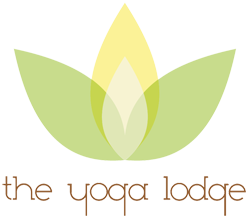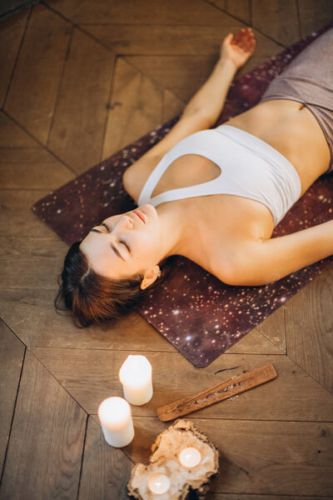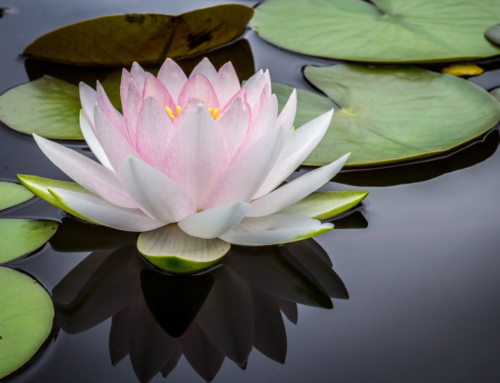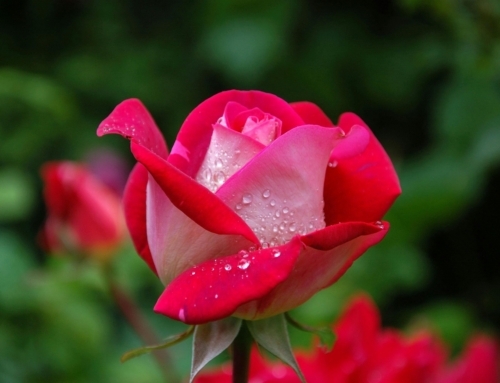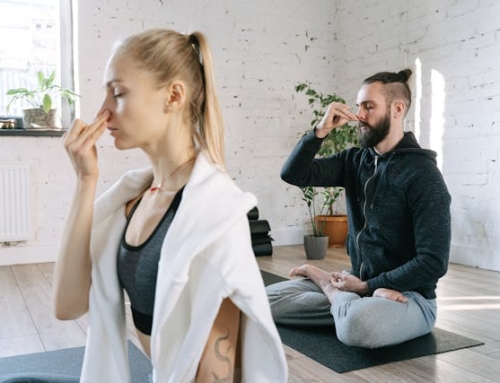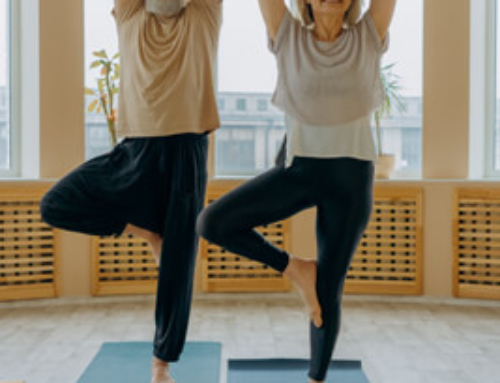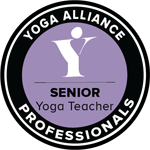YOGA RELAXATION
Welcome to my Blog on Yoga Relaxation. We often live our lives today as if we are in a race, or in a rush, like speeding down the motor way in the fast lane. We hardly ever stop to take a deep breath and look within to connect to ourselves, or look around to connect to our life.
Even though we are warned almost daily by scientists, politicians, health professionals, the media, our family, and friends and by ourselves about the dangers of being ‘stressed out’, we still feel compelled to compete and race towards one goal after another.
Living in such a way creates too much tension. And being too tense for too long can lead to an early grave, or a life of feeling tired and troubled.
We all know, and some of us experience, the consequences of getting too tense. Some of the obvious symptoms are anxiety, nervous troubles, high blood pressure, headaches, allergies, irritable bowel, insomnia, restlessness, dependence on drugs, or alcohol, or sugar, or tobacco. These fairly common complaints are just a few of the problems that too much stress can cause. It is well researched and generally known that an overload of stress can create or worsen illness and disease.
Most of us can feel that we are tense. We are tired, or aching, or irritable, or bored, or fidgety, or angry, or lethargic, or compulsive, or addicted. Maybe we can’t sleep well or can’t stop worrying. Or have panic attacks or feel anxious.
Many of us spend most of the year yearning for the next chance to relax, the next break, the next day off, or holiday. Yet because we are so tense often when the opportunity to rest and relax arrives, we find that we simply cannot ‘unwind’. The habit of racing around physically and mentally has become ingrained. We have lost the ability to feel relaxed, at ease and comfortable with ourselves and our life.
Instinctively we look for ways to ease the discomfort and harm from being too tense. Our favourite methods of trying to relax are consuming alcohol, tobacco, recreational drugs, prescription drugs (tranquillisers), or junk food. They can release ‘happy hormones’ such as endorphins.
The downside of using them as a means to reduce stress is that they can become addictive. Addiction causes a lot more anxiety. Dependency on these crutches can be life destroying by draining our self- confidence.
Help is here though, and indeed has been for thousands of years, taught from teacher to student, guru to chela, down through the centuries in the many forms of yoga. Especially yoga nidra, which is the practice of deep relaxation and through mindful meditation practice. This practise is a harmless and truly profound way to reduce stress. It is free to everyone, easy to do and life enhancing. Practising deep relaxation is definitely an effective, harmless and empowering way of releasing tension.
Stress is indeed necessary under certain conditions
Being stressed means responding to life situations with body and mind fired up with pent up energy ready to strike out. When we get stressed a part of our nervous system is activated. This part of our nervous system, which is a very old defence system that has evolved in all animals, leaps into action every time when we feel confronted by a threat.
It was a valuable system to have for early humans who lived a far more dangerous life than we do. Our defence system was designed to save a person from life threatening danger. If our ancestors had not had such an inbuilt automatic survival strategy we would not be alive today.
If you watch nature programmes you will have some idea of the daily dangers our hunter- gatherer ancestors faced. They needed to be able to move with speed, or fight with strength, when facing a violent attack. The early human survival system needed to move fast. Life and death situations require quick thinking and fast movement. The nervous system’s inbuilt ability to respond with lightening efficiency to danger, by either fighting furiously, or running fast, is called the ‘fight or flight response’. The fight and flight response, which is part of the autonomic nervous system, springs into action every single time we perceive a threat.
When we feel threatened in any way by anything, person or situation we modern humans respond physically, emotionally and mentally exactly the same as our ancestors. We are stuck with an ‘out of date’ survival system. Seldom do we need to fear for our lives, there are no wild beasts hiding behind a bush ready to pounce on us. Even though every little daily threat causes our nervous system to send shock waves of fear or anger through us so that we feel as if a wild beast were about to attack us, actual life or death situations are very seldom a reality for us in our modern lives.
Yet still every little stress imaginary or real, creates the same powerful physical reaction. Our body mobilises all of the forces and energy required for fighting whatever caused the feeling of stress, or for running away from it. In order to fight or flee our metabolism and heart rate increases, blood pressure goes up, and adrenaline and cortisol rushes throughout the body. The body gathers as much energy as it can spare from all the less immediately vital systems such as the digestive system and sends it to the muscles and other body parts used to fight or flee without hesitation and with force. You probably know the feeling well. If you are ‘mindful’ next time you feel tense you may notice a sick feeling in your stomach where your digestive functioning is reduced. You might feel your muscles tensing up, getting themselves ready for a punch up, or a quick sprint. You could feel your muscles tighten as if on ‘stand by’. Emotionally you might sense two powerful emotions, anger or fear rising. They help us fight or flee. Mentally you will notice that rational thinking ceases because in a survival situation there isn’t time to stop and weigh up the pros and cons. Getting away from discomfort back into safety is all that matters in those moments when the fight and flight system is activated.
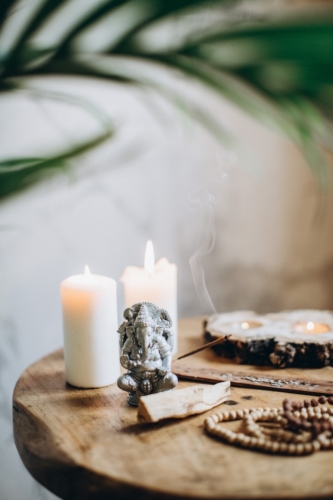
We can be aggressive, impulsive and unreasonable when feeling threatened. It is all a necessary part of the fight and flight response for survival. While it certainly does feel uncomfortable, this response would be harmless if we had a chance to actually fight or flee like our ancestors did when they were hunting for food or protecting their young from enemies. However, in our daily lives it is not acceptable or wise to bop the inconsiderate driver on the nose for cutting us up, or run away from an unpaid bill. Instead we have to stifle this reaction and try to push it down.
Eventually our nervous system does calm down to an extent. But part of us stays keyed up. And before we know it another stressor, real or imaginary, gets us upset. We can be experiencing a continuous background of ‘simmering stress’. Simmering stress creates conditions that can lead to minor and major illness.
For us living in the twenty first century stresses occur in small ways constantly throughout the day, and so we can be living most of our lives ‘wound up’ with a sense of frustration, with little or no experience of real relaxation. The saddest thing is that most of us do not even realise we are stressed out until it is too late and we become depressed or physically ill, or both.
Through yoga we can help ourselves out of this life draining situation. That is because practising yoga relaxation and meditation affects the body in the opposite way to stress, our metabolism, heart rate, blood pressure and breathing rate all lower. Instead of adrenaline flooding the body, endorphins, which are a group of neurotransmitters, are activated. Endorphins enhance the immune system that fights infection and many diseases. Under stress the immune system’s ability to heal is greatly reduced. Practising relaxation releases endorphins to return the immune system to its optimum state. Endorphins also maintain the flexibility and openness of blood vessels, preventing illness such as stroke and heart problems. Too much stress for too long can lead to minor and major illness. The UK has one of the highest rates of death from heart disease in the world – and stroke is the country’s third biggest killer.
Length of life is not as important as quality of life. We all know that to feel anxious and stressed out is horrible. To feel relaxed is just lovely. It is not only healthier but much more enjoyable to be relaxed.
Anxiety creates a vicious cycle
When we respond to situations in a tense and stressful way we release chemicals, such as adrenaline that make us more tense and agitated, which in turn releases more adrenaline and so we feel even more anxious. It can be most upsetting to live feeling almost always anxious.
But when we respond to situations in a more relaxed way, we release chemicals that change how the body feels in a positive way. We slow down, and feel calmer, friendlier, and more able to cope. This in turn affects how others treat us and so we create a cycle of contentment instead of tension.
We can learn how to be in the relaxed state for most of our life by practising yoga nidra and mediation daily. It may take a little time to master, especially if we have been under too much stress for many years. When first learning to slow down we can hit despair at discovering just how tense and uncomfortable we are inside. Instead of running to the bottle or fridge we need to stay still and breathe deeply and soon the discomfort; racing negative thoughts, fearful, angry emotions and restless, fidgety muscles will calm down. The secret is to keep practising; every attempt is a step towards freedom.
Eventually you will become a ‘relaxed person’ not just an anxious person taking time out to relax, but a relaxed person coping more easily with life’s ups and downs. Like a solid rock unharmed even in a raging storm.
The secret of relaxation is to NOT try, but to ‘let go’, let go of worries, let go of physical tightness, let go of expectations.
Eventually through deep relaxation of body, emotions and mind we can feel connection instead of isolation; we can feel at one with ourselves and fully part of the universe. This connection is the state of Yoga. Yoga means connection.
The yoga practice of nidra and meditation teaches us how to relax. Tension can also be released by practising yoga postures, yoga breathing exercises and chanting. Through yoga practice we can safely calm our nervous system and have a more healthy and happy life. And should a wild beast creep up on us, we are still more than able to respond appropriately. Sometimes the fight or flight response saves us from harm. Yoga teaches us, through postures, breathing techniques, relaxation and meditation, how to find balance.
Savasana/Relaxation Pose
This posture can be practised any time you need a few minutes of deep rest. The pose encourages total relaxation. If you have back ache practice with your legs bent with the soles of your feet on the floor. Or alternatively keep your legs straight and place a rolled up blanket under your knees.
Why not give it a go.
You will find several yoga relaxation or breathing recordings on this website under “downloads”.
So go and give it a go and enjoy!
Sit on the floor with your legs bent, soles of your feet on the floor.
Ease yourself down to lie on your back.
Bring your knees onto your chest and your hands around your knees. Gently rock from side to side. After a few rocks, slowly circle your knees, a few times one way and then a few circles in the opposite direction.
Rest your arms alongside your body, palms up and a short distance away from your thighs. Bring your feet down onto the floor then straighten out your legs.
Separate your feet at least hip width apart. Let your feet drop out to either side.
With your head centred tuck your chin in slightly. Stretch up through the back of your neck. Relax your lower jaw. Soften your face muscles, gently close your eyes.
If this pose isn’t possible for you to comfortably achieve practice relaxation lying on the front of your body, or in a sitting position.
If you have ten to twenty minutes to rest you could follow the instructions for progressive relaxation, or any of the other relaxation scripts.
If you only have a few minutes to relax simply let all the muscles of your body loosen and soften. As you exhale visualise waves of relaxation flowing through your entire being washing away stress and tension.
When you feel ready to sit up take your time, Wriggle your fingers and toes, and then stretch your arms and legs. With your legs bent roll over to one side, take a breath, then slowly sit up.
Baby Krishna
If you are pregnant practice relaxation in Baby Krishna pose by lying on your left side, with your right leg bent. Place a folded blanket or a cushion underneath your right knee and your right foot. You will also need one for under your head.
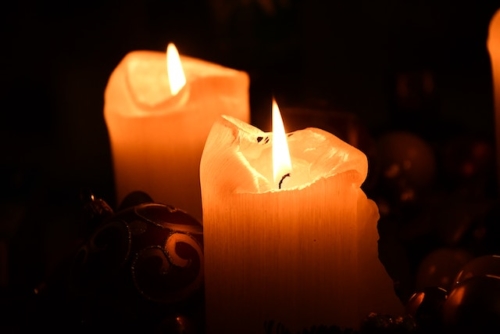
Progressive Relaxation
Relaxation practice helps relieve stress, anxiety and depression. It eases headaches, fatigue, and insomnia. Body and mind benefit from receiving deep rest.
Lying in Savasana breathe deeply…..
Inhaling push away your heels and spread your toes. Exhaling release & relax.
Inhaling lift your hips, & squeeze your buttocks. Exhaling release & relax.
Inhaling push the small of your back towards the floor. Exhaling release & relax.
Inhaling push your chest upwards. Exhaling release & relax.
Inhaling make fists, tense your arms, then spread your fingers. Exhaling release & relax.
Inhaling shrug your shoulders up and in. Exhaling release & relax.
Inhaling draw your chin down to your throat. Exhaling release & relax.
Inhaling screw all your face muscles towards nose, and then exhaling stretch your eyes, mouth and tongue. Release & relax. Gently roll your head from side to side.
Relax with your head and spine in one straight line, your chin in.
Take three deep breaths, exhaling visualising or feeling tension draining away.
Keep softening your whole body from feet to head
Bring your awareness down to your feet and with a gentle inner voice mentally affirm
I relax my feet, I relax my feet, my feet are relaxing, relaxing.
I relax my legs, I relax my legs. My ankles, calves, knees and thighs are relaxing.
I relax my pelvis, I relax my pelvis. My buttocks, hips, and abdomen are relaxing.
I relax my back, I relax my back. My lower, middle and upper back is relaxing.
I relax my chest, I relax my chest. My heart, lungs, and chest muscles are relaxing.
I relax my hands, I relax my hands. My hands are relaxing, relaxing.
I relax my arms, I relax my arms. My wrists, forearms, elbows and upper arms are relaxing.
I relax my shoulders, I relax my shoulders. My shoulders are softening, loosening, relaxing.
I relax my neck, I relax my neck. My neck is relaxing, relaxing.
I relax my face, I relax my face. My chin, mouth, cheeks, eyes, and forehead are relaxing.
I relax my head. I relax my head. My scalp, brain, and head muscles are relaxing.
I relax my whole body. I relax my whole body. Every muscle, organ, nerve and cell, my whole body is relaxing, relaxing, relaxing.
Now take three more deep breaths, feeling your body relaxing even more.
Now rest your mind, for a minute in a beautiful scene. Somewhere you feel at peace with yourself and the world. Maybe a beach, or a beautiful garden, or temple. Any place that brings feelings of relaxation.
Now for another minute imagine your mind is a still deep lake, dive into the stillness and rest. Or imagine your mind is a clear blue sky and soar into the freedom and rest.
When you are ready bring awareness back to your body. Take a deep breath and exhale away any remaining tension. Wriggle your fingers and toes, then stretch your arms and legs. With your legs bent roll over to one side, take a breath, then slowly sit up.
However, if you require further help or assistance in this matter, then contact me when as a dedicated and caring Yoga Teacher, I would be more than happy to help you.
Mobile: 07973 410375
Email: Pavana@theyogalodge.org.uk
